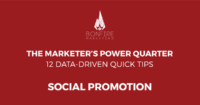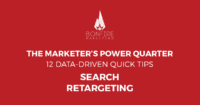We like to use the phrase “post and coast” at Bonfire to describe poor community management of social media. Similarly we educate and encourage our clients to not forget about their website and blog content. Just because it’s live and published, doesn’t mean it’s dead. Especially from an SEO standpoint: We know it can take up to six months for a page or post to rank on page one or two of Google search results.
It’s essential to not only monitor your content over time, but to also tweak and refresh content you’ve determined is of high value to your business goals and meets your audience needs and interests. There are many paid tools to help you determine which pieces of content deserve a revisit. One we use regularly is Moz Pro.
In terms of free tools, though, there’s nothing better than Google Analytics. Here are a few Google Analytics reports and tips to gain insights on content needing optimization.
1. Customize a date range and set up an advanced segment
A general rule of thumb is to analyze data spanning the last six months to a year. However, if you’re monitoring the performance of recently published content, then adjust the time frame accordingly.
Ideally you’ve created personas for your brand. You can use these as a basis for setting up and saving an advanced segment in order to compare what content is working for new visitors vs. your personas.
2. Create goals
It’s never too late to create goals in Google Analytics. Goals are not solely for e-commerce sites. They should be utilized for all types of businesses, even personal portfolio sites.
You can track pretty much any action with a goal, from engagement metrics to newsletter signups, or white paper downloads to leads. There are Google Analytics templates you can use in goal setup. If SEO is a core part of your marketing efforts, then check out our Metrics Monday post on identifying KPIs and setting goals to track SEO ROI.
Two custom engagement metrics we track are a duration goal of visitors spending more than one minute on a page or post, and pages/screens per session goal for those exploring past their landing or entrance page.
Custom duration goal
Navigate to the Admin tab in your GA account. Select Goals under the View column, and then the red button for “+ NEW GOAL.”
Here are the description fields for a duration goal named “More Than 1 Min.” Go with a name that is descriptive and easy to remember.

For the goal details, set your duration and give your goal a monetary value.

Custom pages/screens per session goal
Outside of a landing page for, say, a download or sign-up, you really want users to explore your site to read more content or learn more about your business.

Customize the pages/screens per session goal to fit your ideals.

3. Use Content Drilldown Report for performance analysis and content ideation
You’re ready to analyze content engagement metrics with your segments and goals in place. Let’s start with Behavior Reports.
Google Analytics Content Drilldown Report is one of my favorites. It’s not as useful if you haven’t properly mapped out your site’s architecture. For instance, including a /blog/ subfolder for your blog content is optimal because it allows you to more easily monitor performance versus not having a subfolder or using the year and month in your blog URLs.
Under Behavior in GA, select Site Content and then Content Drilldown. The primary dimension is automatically set to “Page path level 1,” or in other words, by subfolder.

We immediately see for Bonfire that our blog content is our most popular, which is excellent as it’s a primary focus of ours. It has the most pageviews and unique pageviews. It’s one of the top sections of the site for average time on page at 2:09, with the other being our case studies at 2:20.
At a glance, we can see our average bounce rate is not so hot for the blog overall at 80 percent. Ideally users are clicking through to read more of our content, thus a bounce rate of 40 to 60 percent is best. But at the same time, thinking of the user experience for those entering our site via organic search or social media, more than likely those are informational queries in which the user has a single question or topic they’re interested in. In that case, a 70 to 90 percent bounce rate is acceptable. All in all, I would like to see our average blog bounce rate lower. Meanwhile the bounce rates for our primary site pages are stellar, with our home page at 33 percent.
The percentage of those existing sections or pages of your site is worth reviewing as well. This metric also helps you judge whether users or site readers are finding the content valuable.
Next, drill down even further by selecting the /blog/ path from the Content Drilldown Report. From here you gain a better understanding of individual pieces of content. For instance, I see our primary blog page has a super optimal bounce rate and really low exit percentage.
And by reviewing these metrics, you can discover your most popular posts. Examine the content of these posts to figure out why they’re registering with users, and if you can replicate them in the future for other topics.
For posts not performing that well, it means you’re not meeting your reader’s intent. Perhaps the content is mediocre and needs a total rewrite. Or perhaps it’s not informative enough and needs to be expanded upon. Or perhaps a blog post is not the best format for the topic; for instance, maybe video is better. Do an incognito search to understand what’s ranking on page one. Click through the results and do a comparison against your own. What’s missing from your content? Where do you excel?
4. Create a custom dimension for multiple blog authors
If you have multiple contributors to your blog, create a custom dimension for authors. We recommend you also use Google Tag Manager. Here are steps on “Using Custom Dimensions to Make an Author Report.”
You can monitor the performance of bloggers in Behavior Reports with author tracking enabled. Notice certain bloggers bringing in more traffic than others? Time to increase the number of posts they contribute — and move away from the poor performers.
5. Mind your top landing pages, goals, and organic reach
Review your Landing Pages Report as well. It, too, is one of the Site Content Reports located under Behavior. It focuses on those pages visitors entered your site through. You can see the core engagement metrics mentioned above as well as your goals, including goals conversion rates, completions, and value.
If you want to only review goal metrics, navigate and analyze the Conversions Reports. Again, with goals in place, you can more easily zero in on content that’s performing the way you hope and learn from it.
The Landing Pages Report is also very revealing in that it gives you a clear understanding of which topics are popular with your organic search audience. This has been valuable ever since Google introduced “not provided” back in 2011.
Add a secondary dimension for Source/Medium, and then apply an advanced filter to only include “google/organic.”

Alternatively, navigate to the Acquisitions > All Traffic > Channels > Organic Search and edit the primary dimension to “landing page.” You’re able to analyze acquisition, behavior, and goal metrics in this report.
6. Use the Site Search Report for content ideation
The Site Search Report is found under Behavior. It’s useful for understanding not only what type of content is of interest to your visitors, but also which content topics may be missing from your site and any navigation (UX) issues they may be having.
Follow these steps from Google Analytics Help to set up site search.
7. Don dashboards for days
Finally, as you become familiar with the various reports and metrics, you’ll better understand which Google Analytic dashboards you’d like understanding your audience or content performance. There’s much you can do with dashboards outside of quick daily or weekly monitoring. For example, each Bonfire blogger receives via email a monthly dashboard performance report in PDF format. It’s an excellent tool for motivating bloggers and increasing their understanding of Google Analytics.
There are so many ways to analyze content performance in Google Analytics. Share your favorite method in the comment section below!
Related resources:
More Content
The Marketer’s Power Quarter: Boost Social Promotion
This is the ninth in a 12-part series of quick-fix tips to improve your digital marketing results. Catch up on our last tip, and subscribe to our newsletter to get
The Marketer’s Power Quarter: A Local SEO Strategy
This is the sixth in a 12-part series of quick-fix tips to improve your digital marketing results. Catch up on our last tip, and subscribe to our newsletter to get
The Marketer’s Power Quarter: Better Ad Retargeting
This is the fifth in a 12-part series of quick-fix tips to improve your digital marketing results. Catch up on our last tip, and subscribe to our newsletter to get the




Leave A Comment